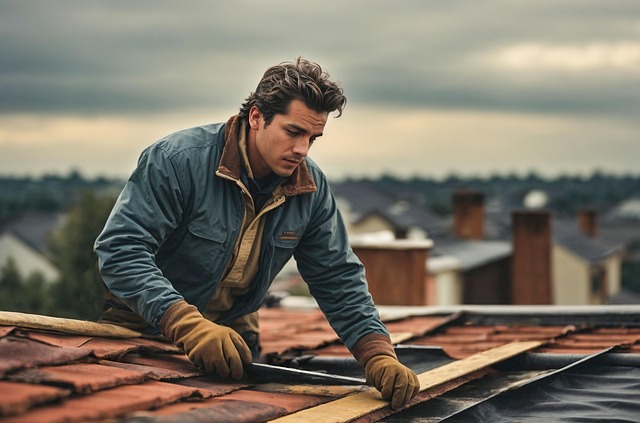Flat roofs, despite their advantages, are vulnerable to weather damage. Early identification through maintenance is key to preventing costly repairs. Lightweight materials are gaining popularity due to enhanced structural integrity, insulation, and weather resistance, extending the lifespan of repairs. Choosing appropriate materials, such as reinforced composites and coatings, offers superior durability and cost savings over time. Strategic approaches, including regular maintenance checks and high-performance membranes, ensure long-term sustainability and minimize flat roof repair needs.
In the realm of roofing, flat roofs present unique challenges. This article explores strategies to enhance their longevity, focusing on lightweight and weather-resistant materials. We delve into the common vulnerabilities of flat roofs, highlighting issues like leaks and structural damage. By adopting lightweight materials, repairs become more efficient and durable. Furthermore, we examine various weather-resistant options tailored to protect against environmental stressors. Ultimately, this guide offers a comprehensive approach to ensure sustainable flat roof repair, empowering professionals and homeowners alike.
Understanding Flat Roof Vulnerabilities: Common Issues and Challenges
Flat roofs, while offering sleek aesthetics and cost-effective solutions, come with their unique set of vulnerabilities. One of the primary concerns is their susceptibility to various weather conditions, especially extreme temperatures, heavy rainfall, and strong winds. These elements can lead to common issues such as cracks in the membrane, water penetration, and overall structural damage over time.
Another challenge with flat roof repair is identifying and addressing problems early on. Unlike slanted roofs, flat roofs often hide damage under tar or other protective layers, making it difficult to spot leaks or deteriorations. Regular maintenance becomes crucial, as timely intervention can prevent minor issues from escalating into major repairs or even roof replacements.
The Benefits of Lightweight Materials in Flat Roof Repair
Lightweight materials offer numerous advantages when it comes to flat roof repair, making them an increasingly popular choice among roofing professionals. One of the key benefits is their ability to enhance the structural integrity of a flat roof while significantly reducing its overall weight. Traditional heavy materials can put immense pressure on roof frames, especially in regions with harsh weather conditions or heavy snow loads. By opting for lightweight alternatives, the stress on these structures is considerably lessened, leading to longer-lasting repairs and reduced maintenance costs over time.
Additionally, lightweight materials provide better insulation, which is crucial for energy efficiency in flat roofs. They can help regulate indoor temperatures, preventing heat gain during warmer months and heat loss in colder climates. This not only reduces the burden on HVAC systems but also contributes to a more sustainable and environmentally friendly building design. Moreover, their weather-resistant properties ensure that these materials can withstand various environmental factors, including extreme temperatures, strong winds, and heavy rainfall, further extending the lifespan of flat roof repairs.
Weather-Resistant Options: Protecting Against the Elements
When it comes to ensuring the longevity of a structure, particularly in regions with varying weather conditions, selecting the right materials is paramount. For flat roof repair and maintenance, there’s a growing trend towards lightweight yet robust weather-resistant options that can withstand harsh elements such as rain, snow, and intense UV radiation. These advanced materials are designed to protect against water intrusion, corrosion, and structural degradation, ultimately extending the life of the roof.
Traditional choices often fall short in terms of resistance to weathering, leading to leaks, cracks, and eventual replacement costs. Modern alternatives, however, offer superior durability and aesthetic appeal. From reinforced polymer composites to specialized coatings, these materials provide an effective barrier against the elements, ensuring that flat roofs remain in top condition for years to come, saving on costly repairs and maintenance.
Longevity Strategies: Ensuring Sustainable Flat Roof Repairs
When it comes to flat roof repairs, implementing longevity strategies is paramount to ensure sustainability and minimize future costs. One key approach involves utilizing lightweight and weather-resistant materials that can withstand the elements while preserving the structural integrity of the roof. This not only extends the lifespan of the repair but also reduces the strain on supporting structures.
Choosing the right materials plays a crucial role in achieving long-lasting results. Modern options include high-performance membranes and coated metal sheets, which offer superior protection against water penetration, UV rays, and extreme temperatures. Regular maintenance checks are equally vital to catch potential issues early, allowing for quick repairs that prevent minor problems from escalating into major, costly damages.
Selecting the Right Products for Optimal Flat Roof Durability
When it comes to ensuring the longevity and durability of a flat roof, choosing the right materials is paramount. Opting for lightweight yet weather-resistant products can significantly reduce the risk of damage from extreme temperatures, harsh storms, and prolonged exposure to UV rays. For flat roof repair and maintenance, professionals often recommend a range of modern materials designed to mimic traditional roofing while offering superior resilience.
Selecting these products involves considering factors like insulation properties, impact resistance, and ease of installation. Modern flat roof systems often incorporate advanced membranes or sheets made from high-performance polymers or synthetic rubber, which provide an effective barrier against water penetration while withstanding the rigors of diverse weather conditions. This approach not only enhances the structural integrity of the roof but also minimizes the need for frequent repairs, making it a practical and cost-effective solution in the long run.
In addressing the challenges of flat roof repair, adopting lightweight and weather-resistant materials is a strategic move towards longevity. By understanding the vulnerabilities specific to flat roofs, we can leverage the benefits of modern materials to enhance durability and performance. The right combination of products ensures that flat roofs not only withstand the elements but also maintain their structural integrity over time, providing sustainable solutions for both homeowners and commercial property managers alike.
